
Mikhail G Kataev
Fyodorov Eye Microsurgery Complex, Russia
Title: Oculoplasty for saving vision in children
Biography
Biography: Mikhail G Kataev
Abstract
Background: Normal morphology and function of ocular adnexa and orbit are critical in maintaining perfect vision. Early age is a most vulnerable period for developing vision function in children. Impairment of vision due to external ocular problems can be caused by epicorneal opacity or by the lack of seeing because of irritation, blepharospasm, epiphora, ptosis or strabismus.
Materials & Method: The whole cohort of more than 7000 pediatric oculoplastic patients in our data base contains about 4000 individuals susceptible to vision impairs. Oculoplastic surgery was indicated in cryptophthalmos, congenital symblepharon, and epicorneal opacity after burn, SJS, toxic epidermal necrolysis (TEN) causes direct blurring of the vision field. Potential risk of low vision (amblyopia) was an indication for surgery in strabismus, ptosis, and secondary blepharospasm, caused by conjunctival metaplasia, trichiasis, distichiasis, and entropion. The third indication was lagophthalmos due to eyelids skin deficit, ectropion or coloboma. All possible types of surgery were used to solve adnexal problems. Percent distribution in this specific group showed as follows: ptosis surgery 57%, strabismus surgery 17%, reconstruction of eyelids and fornices 21%, trichiasis 3% and orbital surgery 3%.
Results: The effect of treatment was evaluated by eyelids shape, proper mucous lining of the fornices, sufficient opening and closure of the eye fissure. In 98% of patients, anticipated result was achieved. Multistep surgery was often needed as a normal way of treatment. No serious complications were observed.
Conclusion: The effect of oculoplastic procedures corresponds differently with regaining of vision function. The correlation depends on the type of pathology. Ptosis and common strabismus repair leads to good outcome. Elimination of trichiasis and dysplasia of the conjunctiva facilitates vision and improvement in function. Meanwhile, restoration of the fornices in TEN patients suffering from dry type of lesion may stay poor. Nevertheless high rate oculoplastic surgery is a powerful tool for restoration of ocular adnexa and providing proper background enabling function repair.


